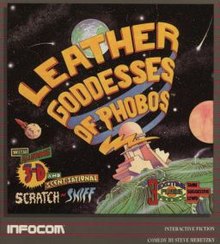Infocom was an American software company based in Cambridge, Massachusetts, that produced numerous works of interactive fiction. They also produced a business application, a relational database called Cornerstone.
Interactive fiction (IF) is software simulating environments in which players use text commands to control characters and influence the environment. Works in this form can be understood as literary narratives, either in the form of Interactive narratives or Interactive narrations. These works can also be understood as a form of video game, either in the form of an adventure game or role-playing game. In common usage, the term refers to text adventures, a type of adventure game where the entire interface can be "text-only", however, graphical text adventure games, where the text is accompanied by graphics still fall under the text adventure category if the main way to interact with the game is by typing text. Some users of the term distinguish between interactive fiction, known as "Puzzle-free", that focuses on narrative, and "text adventures" that focus on puzzles.

Zork is a text adventure game first released in 1977 by developers Tim Anderson, Marc Blank, Bruce Daniels, and Dave Lebling for the PDP-10 mainframe computer. The original developers and others, as the company Infocom, expanded and split the game into three titles—Zork I: The Great Underground Empire, Zork II: The Wizard of Frobozz, and Zork III: The Dungeon Master—which were released commercially for a range of personal computers beginning in 1980. In Zork, the player explores the abandoned Great Underground Empire in search of treasure. The player moves between the game's hundreds of locations and interacts with objects by typing commands in natural language that the game interprets. The program acts as a narrator, describing the player's location and the results of the player's commands. It has been described as the most famous piece of interactive fiction.

Steven Eric Meretzky is an American video game developer. He is best known for creating Infocom games in the early 1980s, including collaborating with author Douglas Adams on the interactive fiction game of The Hitchhiker's Guide to the Galaxy, one of the first games to be certified "platinum" by the Software Publishers Association. Later, he created the Spellcasting trilogy, the flagship adventure series of Legend Entertainment. He has been involved in almost every aspect of game development, from design to production to quality assurance and box design.

Return to Zork is a 1993 graphic adventure game in the Zork series. It was developed by Activision and was the final Zork game to be published under the Infocom label.
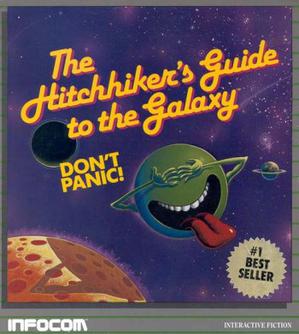
The Hitchhiker's Guide to the Galaxy is an interactive fiction video game based on the comedic science fiction series of the same name. It was designed by series creator Douglas Adams and Infocom's Steve Meretzky, and it was first released in 1984 for the Apple II, Mac, Commodore 64, CP/M, MS-DOS, Amiga, Atari 8-bit computers, and Atari ST. It is Infocom's fourteenth game.

A Mind Forever Voyaging (AMFV) is an interactive fiction game designed and implemented by Steve Meretzky and published in 1985 by Infocom. The game was intended as a polemical critique of Ronald Reagan's politics.

Wishbringer: The Magick Stone of Dreams is an interactive fiction video game written by Brian Moriarty and published by Infocom in 1985. It was intended to be an easier game to solve than the typical Infocom release and provide a good introduction to interactive fiction for inexperienced players, and was well received.

Planetfall is a science fiction themed interactive fiction video game written by Steve Meretzky, and published in 1983 as the eighth game from Infocom. The original release was for Apple II, Atari 8-bit computers, TRS-80, and IBM PC compatibles. Atari ST and Commodore 64 versions were released in 1985. A version for CP/M was also released. Planetfall was Meretzky's first published game, and it proved one of his most popular works and a best-seller for Infocom. It was one of five top-selling games to be re-released in Solid Gold versions with in-game hints. Planetfall uses the Z-machine originally developed for Zork and was added as a bonus to the Zork Anthology.

The Lost Treasures of Infocom is a 1991 compilation of 20 previously-released interactive fiction games developed by Infocom. It was published by Activision for MS-DOS, Macintosh, Amiga, and Apple IIGS versions. It was later re-released on CD-ROM, and in 2012 on iOS.

Beyond Zork: The Coconut of Quendor is an interactive fiction video game written by Brian Moriarty and released by Infocom in 1987. It was one of the last games in the Zork series developed by Infocom. It signified a notable departure from the standard format of Infocom's earlier games which relied purely on text and puzzle-solving: among other features, Beyond Zork incorporated a crude on-screen map, the use of character statistics and levels, and RPG combat elements.
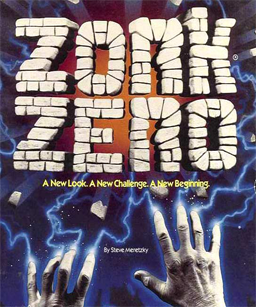
Zork Zero: The Revenge of Megaboz is an interactive fiction video game, written by Steve Meretzky over nearly 18 months and published by Infocom in 1988. Although it is the ninth and last Zork game released by Infocom before the company's closure, Zork Zero takes place before the previous eight games. Unlike its predecessors, Zork Zero is a vast game, featuring a graphical interface with scene-based colors and borders, an interactive map, menus, an in-game hints system, an interactive Encyclopedia Frobozzica, and playable graphical mini-games. The graphics were created by computer artist James Shook. It is Infocom's thirty-second game.

Moonmist is an interactive fiction game written by Stu Galley and Jim Lawrence and published by Infocom in 1986. The game was released simultaneously for the Amiga, Amstrad CPC, Apple II, Atari 8-bit computers, Atari ST, Commodore 64, MS-DOS, TRS-80, TI-99/4A, and Mac. It is Infocom's twenty-second game. Moonmist was re-released in Infocom's 1995 compilation The Mystery Collection, as well as the 1996 compilation Classic Text Adventure Masterpieces.
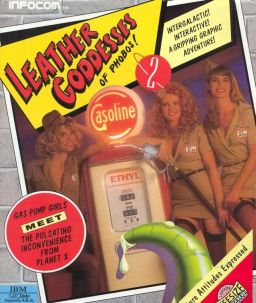
Leather Goddesses of Phobos 2: Gas Pump Girls Meet the Pulsating Inconvenience from Planet X! is a graphic adventure game written by Steve Meretzky and published by Activision in 1992 under the Infocom label. LGOP2 is the sequel to the 1986 interactive fiction game Leather Goddesses of Phobos, also written by Meretzky. LGOP2 featured full-screen graphics and a point-and-click interface instead of Infocom's text parser.

Robert Bates is an American computer game designer. One of the early designers of interactive fiction games, he was co-founder of Challenge, Inc., which created games in the 1980s for the pioneering company Infocom. After Infocom's dissolution in 1989, Bates co-founded Legend Entertainment to continue publishing games in the Infocom tradition, but with added graphics. Notable games that he has designed, written, or produced include Unreal II (2003), Spider-Man 3 (2007), and Eric the Unready (1993), listed as Adventure Game of the Year by Computer Gaming World magazine and also included on the 1996 list of "150 best games of all time". In 1998 he wrote the award-winning game Quandaries for the U.S. Department of Justice. He has twice been the chairperson of the International Game Developers Association, which honored him with a Lifetime Achievement Award in 2010. Bates has written extensively about game design and development in works such as the 2001 book Game Design: The Art and Business of Creating Games, which is commonly used as a game design textbook in college courses. From 2011–2014, Bates was Chief Creative Officer for External Studios at Zynga. He continues to work as an independent consultant with various publishers in the games industry.

The Space Bar is a 1997 graphic adventure game developed by Boffo Games and published by Rocket Science Games and SegaSoft. A comic science fiction story, it follows detective Alias Node as he searches for a shapeshifting killer inside The Thirsty Tentacle, a fantastical bar on the planet Armpit VI. The player assumes the role of Alias and uses his Empathy Telepathy power to live out the memories of eight of the bar's patrons, including an immobile plant, an insect with compound eyes and a blind alien who navigates by sound. Gameplay is nonlinear and under a time limit: the player may solve puzzles and gather clues in any order, but must win before the killer escapes the bar.
Classic Text Adventure Masterpieces of Infocom is a collection of 33 computer games from interactive fiction pioneer Infocom, and the top 6 winners of the 1995 Interactive Fiction Competition, released in 1996. All 39 games are combined on a single cross-platform CD-ROM, which also includes PDFs of all the Infocom games' instructions, maps, and hint booklets.
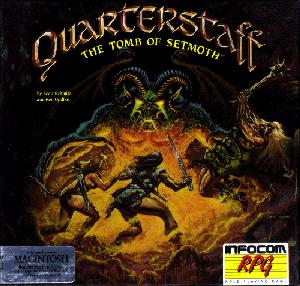
Quarterstaff: The Tomb of Setmoth is an interactive fiction role-playing video game developed by Scott Schmitz and Ken Updike and released by Infocom for Macintosh in 1988. The game features a text parser, graphics, a dynamically updated map, and a graphical interface that incorporates Mac OS hierarchical menus.

Spellcasting 101: Sorcerers Get All the Girls is a 1990 adventure game. It was the first installment of the Spellcasting series created by Steve Meretzky during his time at Legend Entertainment. All three games in the series tell the story of young Ernie Eaglebeak, a student at the prestigious Sorcerer University, as he progresses through his studies, learning the arcanes of magic, taking part in student life, and meeting beautiful women.
The Interactive Fiction Collections is a video game series developed by Infocom and published by Activision for the PC and classic Mac OS.
